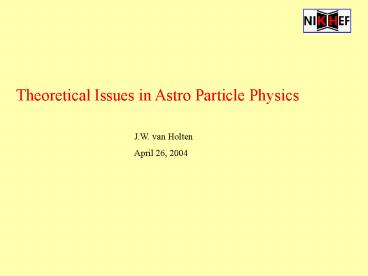Theoretical Issues in Astro Particle Physics - PowerPoint PPT Presentation
Title:
Theoretical Issues in Astro Particle Physics
Description:
The solar system is made from quarks (baryons) and leptons, ... long-range scalar fields (inflation, quintessence) quantum gravity, gravitational waves ... – PowerPoint PPT presentation
Number of Views:37
Avg rating:3.0/5.0
Title: Theoretical Issues in Astro Particle Physics
1
Theoretical Issues in Astro Particle Physics
J.W. van Holten April 26, 2004
2
The solar system is made from quarks (baryons)
and leptons, interacting via weak,
electro-magnetic and strong color forces.
This are the only forms of matter we have been
able to create in accelerators at energies up 1
TeV
The dominant contribution to the mass of the
universe apparently comes from other forms of
matter.
3
Neutrino masses
See-saw mechanism large Majorana mass-scale M
Higss-induced Dirac masses m generates large
neutrino hierarchy
( )
0 m m M
2
2
m ½M ½?(M 4 m ) M or m /M m
m
_
2
M
6-8
2
-3
2
with M 10 GeV ?m 10 eV
(Superkamiokande, SNO)
4
Accelerator physics
Extrapolation of running gauge couplings of
standard model
16
M 10 GeV
GUT
Extrapolation of gauge couplings in the MSSM with
TeV-scale supersymmetry breaking
5
Supersymmetry and MSSM
- All gauge and Higgs bosons have spin-1/2
partners - All quarks and leptons have spin-0 partners
- The known MSM particles are distinguished from
their - superpartners by a new quantum number
R-parity - R-parity conservation a lightest superpartner
stable - LSP candidate
- neutralino ? partner of photon / Z-boson /
Higgs boson - gravitino ? partner of graviton
6
- Neutrino masses, mixing and oscillations
- dark matter ? supersymmetry / LSP
- UHE cosmics -gt GUTs, relics, black holes
- compact objects -gt new types/phases of bulk
matter - dark energy -gt inflation, cosmic scalars
- quantum gravity -gt black holes, big bang
7
Rotational velocities of stars in galaxies
deviation from Kepler motion
Dark matter
8
WMAP survey of Cosmic Microwave Background
flat universe 5 baryonic matter 25
non-baryonic matter 70 dark energy
9
Neutralinos have standard weak interactions
? p cross-sections 10 pb lt s lt 10 pb
for 100 GeV lt m lt 400 GeV (Ellis et al.,
2003) can accumulate in compact objects
(stars, planets) can annihilate to produce
neutrinos
-11
-7
?
10
New phases of matter
- QCD changes collective behaviour of quarks and
gluons at high temperature and/or density - deconfinement quarks become free
- chiral symmetry restoration quarks become
massless - color superconductivity
- BCS-type quark pairing
- massive gluons
(M. Alford)
11
New phases of matter
Heavy-ion colliders QGP, color glass
condensate compact cosmic objects neutron
stars, strange stars, quark stars (?)
neutron matter, strange matter, color
superconductivity reflected in
equation of state (mass-radius relation)
12
Cosmic accelerators
13
20
Highest-energy cosmics E 3 x 10 eV On
collision with an oxygen nucleus
?s 3 x 10 GeV
6
Accelerating mechanism? Travel through
intergalactic space? GKZ cut-off
Dynamics of interaction quark-gluon
plasma?
14
HiSPARC Nijmegen (NAHSA) has recorded the
highest-energy event ever observed in the
Netherlands 0.3 J / nucleon
15
Compact and hot early universe window on
ultra-short distance physics unification of
gauge interactions long-range scalar fields
(inflation, quintessence) quantum gravity,
gravitational waves
16
Neutrinos
- solar neutrinos
- atmospheric neutrinos from cosmics interactions
- background neutrinos
- high-energy cosmic neutrinos































